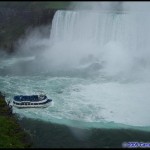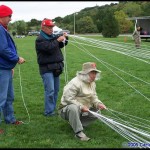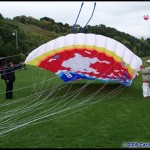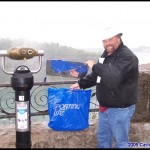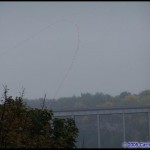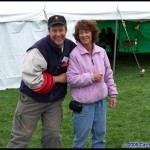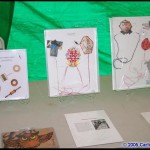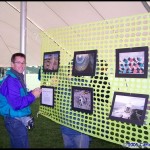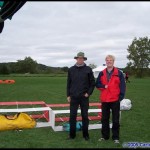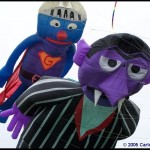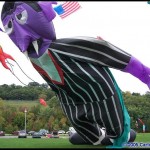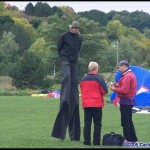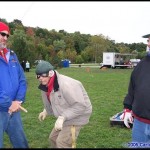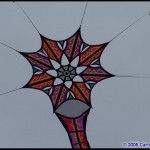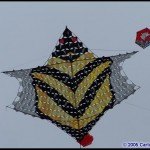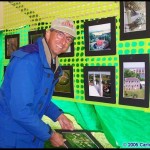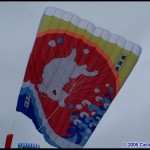The Niagara Festival began on a cold and rainy Friday, October 7th, held through the 9th.
Competitors from all over the world lined both sides of the Canadian and American border for a re-enactment of the historic 1848 Homan Walsh kite crossing of the Niagara Gorge. A very quick bit of history is required here. Back in 1848 the first suspension bridge to span the Niagara Gorge was being planned. The problem of the day was trying to get the first steel cables across the very fast and dangerous river below. It was decided that the easiest solution was to hold a contest. The first person to get a kite across the gorge would win a cash prize. The kite line could then be used to haul over heavier and heavier lines till eventually a steel cable could be pulled across. The contest was a huge success as many people showed up for a chance to win a prize. In the end it was a fifteen year old American boy named Homan Walsh that got that first kite across the falls.
This past October various teams from The USA, New Zealand, Japan, Germany, Israel, Canada and other countries made several attempts to get their kites to span the falls. Kites were launched From Table Rock and Victoria Park on the Canadian side and Terrapin Point, Goat Island on the US side of the falls. Many styles of kites including Rokkakus, sled kites, fighter kites, African fishing kites and even stacks of Dyna Kites began to fight their way across the gorge.
Just for this event, the wind somehow decided it should pick an unusual new direction. I guess the falls felt we needed a bit more of a challenge. On this day the wind was blowing along the gorge upstream past the Rainbow Bridge, past the American Falls and directly towards the menacing Horseshoe Falls. The worst possible imagined wind direction would pose many challenges. There was some initial confusion amongst the teams. No one knew for sure if attempts would be better from the American or Canadian side. Any successful crossings from either side would require working the kite in stages over to the other side. After sides were picked several kites jumped into the air and battled for a good direction. Some attempts ended up lost in the heavy mist, some broke free due to line snags on rocks and some other kites simply broke apart in the high swirling winds above the falls. Watching several kites plunge into the falls was simply, fascinating! It became apparent that more controllable kites like fighters & stunt kites had the best chance of spanning the falls.
The Japanese team waited for a couple of hours forsomeone to get across. The idea was to use the winning kite to pull the Japanese kite train across the falls to form an arch. The Japanese came up with their own method of crossing. They decided to simply walk their train of hundreds of kites right across the Rainbow Bridge. The train was a beautiful site. It was made up with flag images from all over the world. This was a true world event and the train looked great as it spanned the bridge from Canada to the US.
Okay, so the Japanese won the event because they actually managed to span the falls. In fact it was Vaino Raun of St. Catharines, Ontario and his faithful team of Niagara Wind Riders that got the closest to actually flying across the gorge. Vaino started his mylar fighter kite at Table Rock on the Canadian side. After letting out several hundred feet of line at a super fast pace he began working the kite towards the American side. Reports from Prospect Park on the American side claimed that all of a sudden this shiny silver kite came out of nowhere. The mist of the falls had concealed most of the kite’s journey. The kite got as close as twenty feet from landing on the US side. It just never managed to get any closer. While attempting to gain some altitude for control the fighter dived straight into the falls. It appeared all was lost until cheers were heard as the fighter shot upwards out of the mist and the brink of the falls. This diving action repeated itself a total of three times before the kite finally gave into the Mighty Niagara. Twenty feet from landing on Terrapin Point was good for second place in the contest. So, in the end no one actually managed to fly across the falls but everyone sure had a super time trying. That night countless tales of near misses, line breaks and spectacular crashes kept us all talking for hours and hours.
Saturday and Sunday featured the more traditional kind of kite festival we all know and love. Artpark in Lewiston, New York hosted the kite event for the next two days. The rain had finally stopped but strong cold winds from Canada ruled the skies for the next two days.
A tent was set up to display various aspects of kite history. There were historical documents, Garber and Gibson girl kites by Bill & Meg Albers , Miniature kites and workshop by Glen Davison, Stamp collections of Russ & Pat Mozier, Aerial photographs by Carl Bigras and Craig Wilson, and a traction display by none other than Peter Lynn himself.
The crowds that gathered thought the aerial display of kites was terrific. Giant inflatable Sesame Street characters known to all as, “The Count” and “Super Grover” ruled the sky. Christian and Volker Hoberg also known as “Team No Limit” brought these kites over from Germany. As always, Peter Lynn’s huge inflatables such as Mega Ray, Penguin, and the Bear were a big hit too! A lot of people commented that they had no idea what this kite festival was all about until they visited the Artpark. The flow forms of Mr. and Mrs Modegi and Mr. and Mrs Nakamura were beautiful. The common theme of Rabbits and water depicting Fertility and good health were spectacular to see in the sky. I will never forget the vision of one of the Japanese ladies holding onto the international kite train while dancing a bit of a jig. She would lure passers by with her dancing and huge smile. She would then ask them to take hold of the kite train for a bit. It was a very nice way of getting people involved with the event.
The “Three Amigos” also known as Dean Jordan, Scott Skinner and Jose Sainz also put on a great show for the crowds. It was not only their beautiful flying artwork that was impressive. All three of them really took the time to speak to people watching the spectacle. They answered any questions and always had a quick or witty joke to share. While the big kites are always fun I must also mention the kites of Michele Berube and Jean Lamoureau. Michele and Jean managed to fly four single line butterfly kites at the same time. It was great to sit back and watch these kites flutter in the wind.
Some of you may not know this but this is the second time this festival has been held in Niagara Falls. Back in May of 1992 Bill and Meg Albers organized the first International event. It sure was a long time between events, but there is some really good news for next year. Right now Meg and Bill Albers and the Great Lakes Kitefliers Society are working on plans for a 2006 Niagara event. Nothing is official yet but make sure and check the Niagara Event website for future news.
I can only imagine how complicated the logistics of organizing an event that span two borders can be. I heard several conversations regarding the planning for this event. Getting permission to fly kites across the border at the falls is quite complex. With the organizing skills of the Albers, Kate Scalglione, the Niagara Tourism and Convention Corporation, and the support of the GLKS, AKA and major sponsors, 2006 could be the year to visit Niagara Falls! With over 150 years of kite flying history, it’s a great place to visit and fly a kite!
Good flying,
Carlos Simoes


